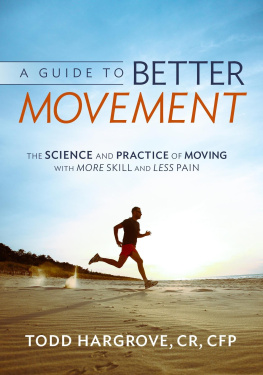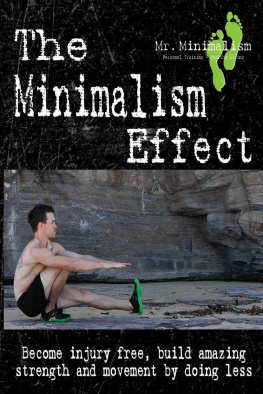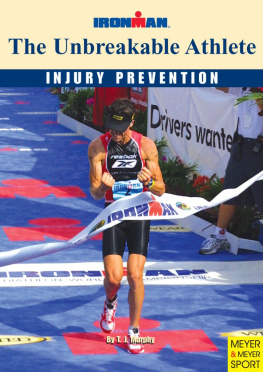MOVE LIKE THE GREATEST OF ALL TIME AT H L ET E S MOVE LIKE THE GREATEST OF ALL TIME AT H L ET E S
JOSE BOESCH, COACH GIL
Text Reid Singer, on behalf of Story Terrace Cover Design Carly Langford Design Adeline Media, London
Copyright Jose Boesch
First print May 2019 www.StoryTerrace.com
CONT E NT S
2. PR E-MOV EM E N T
FU N DA M EN TA LS 23
Squat 27
Hinge 28
Stork Stand 29
Walking 29
3. TRAINING TO PERFECT
GOATA MOVEMENT 55
5. DRILLS AND EXERCISES
FOR GOATA STRENGTH 89
6 . DRILLS AND EXERCISES
FOR GOATA FLUIDITY 109
7. DRILLS AND EXERCISES
FOR GOATA EXPLOSIVITY 117
HOW THE GOATA SYSTEM WA S BOR N
S
ports are an essential part of my lifeand always have been.When I was growing up in Louisiana, the men in my family loved watching NBA or NFL games on TV,
but we were rarely indoors, and I was at my happiest when I had a basketball or football in my hands. Over the years, Ive become a passionate cyclist and swimmer, and I can hold my own against my brothers on the golf course, where they often play with a single-digit handicap. Movement is our thing and, as middle-aged men, were still serious athletes.
But over the years, my passion for competition hasnt always served me well. As a kid, most of my coaches were too busy working with more naturally-talented young players to make sure that the rest of us were staying strong and balanced as our bodies grew. When I walked or ran, I spread my feet to avoid the chafing pain of my thighs rubbing together, and over time, I developed duck feet. My posture was flawed, and loads of physical activity during puberty made me an easy mark for Osgood-Schlatter, a condition that causes a hard, bunion-like bump to grow just below the kneecap. I still remember being cut from the varsity basketball team at age sixteen, and hearing the coachs explanation, which reflected common attitudes from the time about whether real athletes were made or born.
You got bad feet, and bad hips, he told me. We cant work with you.
I still loved to play, of course, and stayed involved in rec ball and intramurals, but without the necessary guidance and attention, I developed habits I would later regret. In high school and college, my approach to movement left me exposed to injuries that would keep me off the court or playing field for months at a time. I was still in school when I had my first major back episode, while doing back squats with warm-up weights in the gym, and sought out the help of the family doctor, who diagnosed simple back strain and said that the discomfort would go away. After a while, I started feeling better, but about ten months later, I suffered another episode and started seeing a specialist. Over the next six years, I ended up visiting no less than eight chiropractors, but the acute pain kept returning again and again.
These people were not quacks. They knew what they were doing, but, like many physicians, they tended to look at the most immediate source of pain, while allowing the underlying causes to go unaddressed, so that relief came in short, fleeting bursts. I had similar problems when I went to see an expert in sports medicine, who had me doing simple, load-bearing movements on a Nautilus machine to build skeletal muscle. The exercises did little to decompress my spine; even as I made progress with the amount of weight I could move, I didnt feel like I was really getting stronger on a structural level.Things finally came to a head in 1999, before my twentyninth birthday, when I suffered yet another back episodemy fortieth of all timeafter sneezing. At this point, I needed regular epidural shots just to be comfortable enough to walk and move around. Deeply depressed and unable to play and roughhouse with my three-year-old son, I found a surgeon who proposed an operation to fuse three degenerated discs in my lumbar vertebrae together with a hunk of titanium. Spine surgery is an inherently risky undertaking, and I was anxious about how it would affect my long-term quality of life. I knew that even if the operation was a success, my mobility would never be the same again, but, at least in theory, I wouldnt be in constant pain.
Two weeks before the surgery was scheduled to take place, I encountered a book titled Pain Free: A Revolutionary Method for Stopping Chronic Pain by Pete Egoscue, recommended by Tony Robbins, one of my favorite motivational speakers. At this point, my back and posture problems were so serious that I found it hard to believe any amount of coaching or low-impact therapy could dig me out of the hole. But after reading Petes book, I was moved to contact him directly, and eventually paid him $200 for a remote consultation from his office in San Diego. (After spending about $16,000 in medical insurance copays, and out-of-pocket payments to chiropractors for at least $35 per session, this felt like a bargain.)
Most of my therapy was done using a fax machine. Id send along scanned pictures of myself standing up against a wall, and Pete would draw a simple grid over my shoulders, hips, knees, and ankles. On a healthier individual, the lines of the grid would have met in all right angles, but my own case was a mess of crooked markers and sharp diagonals, with shoulders drooped unevenly, hips protruding outwards, and ankles and knees that were splayed open to the sides. Id been involved in competitive sports for years, and it seemed far-fetched that I could have overlooked simple concepts of muscular and skeletal alignment this badly or that I could train myself back into mobility.
On the other hand, Id worked for years as an assistant to my step-father, an experienced carpenter, who taught me to pay attention to how structures are built to bear weight against the pull of gravity. I was intrigued by how Pete made use of these same concepts in his work as a physical therapist and, under his guidance, I agreed to delay my back surgery until every corner on my grid was brought to 90 degrees.
My work with Pete was slow and methodical, but dazzlingly effective, and it allowed me to stay active, have fun, and avoid surgery for good. I eventually attended his online classes and, in 2008, I traveled to California and became certified as an Egoscue Institute PAS (Postural Alignment Specialist). In the years since, Ive recommended his book to athletes, coaches, and trainerspretty much anyone who wants to stay comfortable and mobile for the next twenty years or more.
Soon, I was back to my favorite sports again, trying new ones, and playing my first full round of golf in at least three years. My approach to exercise and fitness was completely changed, and things got particularly interesting when I got involved in spinningfirst as a student, then as a teacher and began training for triathlons, hoping to change my body composition and improve my cardiovascular capacity. My first race wasnt prettyit took me 23 minutes to swim 600 metersbut I was inspired by other competitors, many of whom looked surprisingly strong and spry for their ages. In a duathlon three years later, a 68-year-old man left me in his dust during the running portion, even though I was sure I could beat him at first.
Granted, lots of people get into triathlons relatively late in life. If youve spent time in the world of endurance sports, youve probably seen men and women with grey hair passing the finish line in the final hour of a marathon or other longdistance race, usually in an awkward shuffle of cramped legs and arms, and clearly enjoying only a fraction of the flexibility and range of motion that they used to. But this guy was different: instead of a bowed back and a stuttering gait, he had an upright posture and moved in easy, open strides. Instead of holding his arms stiffly close to his chest, his hands moved gently at his sides. Despite what must have been decades of compressive sittingand miles spent on the roadhe ran with the mobile hips and flexible lower-back of a twentysomething. It was as if an invisible rope was tied to his waist, gently pulling him through the course.







